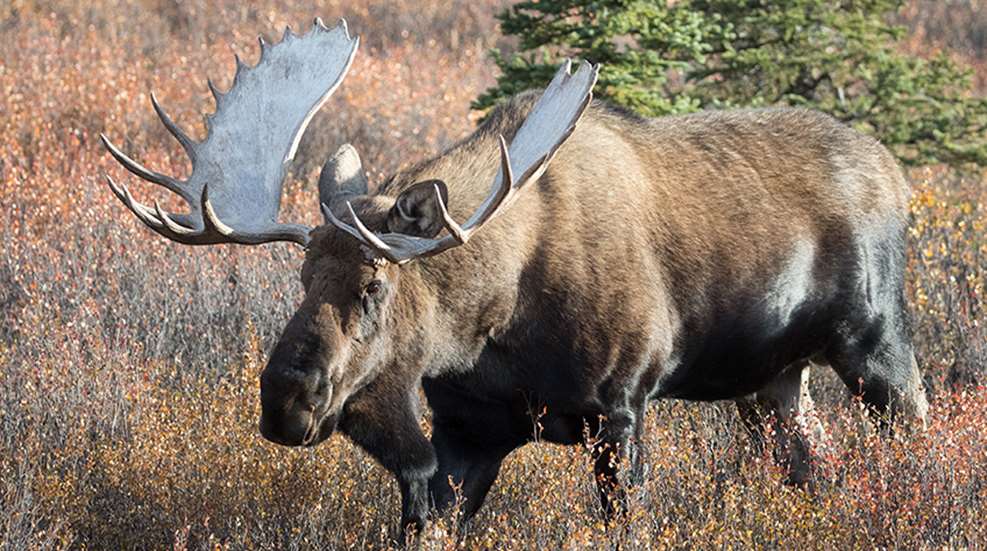
When Drew Goodlin says a new project involved “a lot of science,” I know to tread carefully. Every few years Drew and I get away for a little hunting-camp one-on-one that helps inform our reporting on products resulting from his work as Federal’s VP of product development. It’s important I learn enough about the design and basic ballistics to explain how they will perform, but when Drew starts in on the math and physics, I’m a goner.
Not that I spend these hunts buried in my notebook, far from it, especially when we’re with our go-to outfit, Collingwood Brothers in northern British Columbia. More likely Drew is in his saddle and I’m in mine, and often drainages apart, since Reg Collingwood’s idea of hunting holds that for every hour spent glassing or stalking, there’s got to be two hours on horseback. But who can argue, since Drew and I have experienced first-hand why they are among the world’s premier outfitters for Stone sheep, mountain goat, black bear, moose and mountain caribou? Before 2018, grizzly bears headed that list, but that was tragically shut down by anti-hunting politicians despite lack of scientific data.
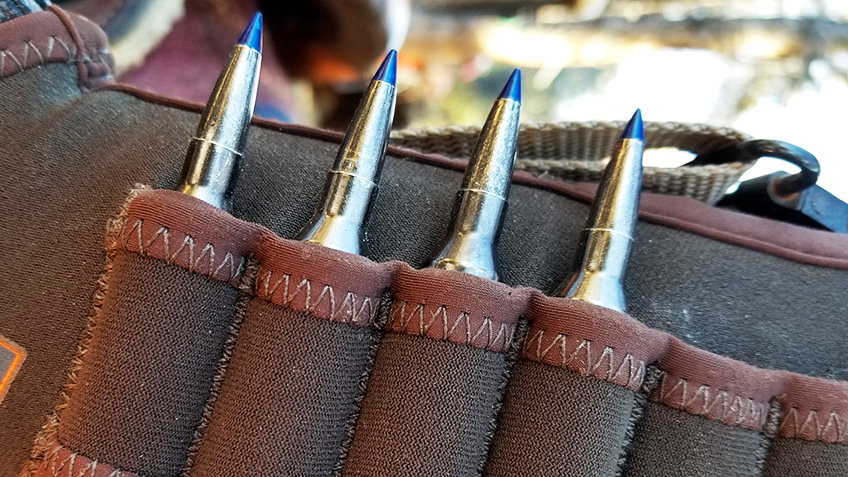
Back for our fourth go last fall, we focused on the antlered beasts; moose that, but for a few hundred miles, would be grouped in the alpha Alaska-Yukon subspecies; plus stately caribou that inhabit the region’s weird mountaintop plateaus. The ammo supplied for my use this time was Federal Premium Edge TLR, a line expressly developed to compete in the ultra-high ballistic-coefficient derby that has emerged as an increasing number of hunters invest in the equipment and skills to go long range. The Edge TLR (Terminal Long Range) bullet is one of those “a lot of science” breakthroughs, but its positives aren’t difficult to grasp even for those of us with no working knowledge of calculus.
Even so a few numbers will help introduce the TLR, chiefly ballistic coefficient (BC), which expresses a bullet’s flight efficiency. In this case we’ll refer to both the familiar G1 BC and the newer G7 scale standardized for streamlined projectiles like the TLR. Higher BCs on both scales indicate flatter trajectory, reduced wind drift and greater terminal energy.
While the BCs are similar, the Edge TLR differs significantly from competing bullets in a few ways. Notably, it is a bonded construct, closely resembling Federal’s highly esteemed Trophy Bonded and Trophy Tip projectiles. Because of their consistent expansion/penetration dynamic, many hunters now favor bonded bullets over the simpler cup-and-core type for rapid knockdown of animals larger than deer.

The TLR also has a single groove cut into its shank, a feature intended to make it accurate in more barrels. Such grooves are particularly common in hard, all-copper bullets, where they allow the surface material to “flow” in order to form a better fit with the bore surface. While multiple grooves are the norm, Federal stuck with one on the TLR to minimize wind-resistance over longer ranges. The groove was also carefully engineered with a curved rear face, rather than cut square, to further reduce friction. Of course it wears an aerodynamic, long-ogive plastic tip, made from material Federal says is the most heat-resistant currently in use. This Slipstream Tip is designed to break away upon contact and thereby helps to initiate expansion at a wide range of impact velocities.
Contributor Bryce Towsley did a deep dive on the Edge TLR and concluded: “While I have seen such performance with match-grade factory ammo and select handloads, very few factory hunting loads have exhibited this level of accuracy and long-range predictability.”
Despite the TLR’s long-range credentials, Federal touts it as a versatile, do-everything big-game bullet, terminally effective from the muzzle to way out yonder. That dovetails with the way I hunt and with what I think hunters need in a bullet, regardless how they want to hunt. I don’t aspire to shoot big game at great distances, but do prepare to take long shots to the extent feasible. Perhaps that sounds contradictory, but more so it shows that notions of long-range hunting can be subjective. For some, “long shots” start somewhere between a quarter- and a half-mile, or even farther. I tried that once and managed to kill the elk cleanly, but realized I would need to up my skills before trying that again. For this hunt, I was able to work out my Bergara B-14 Ridge in 7mm Rem. Mag. on paper and steel targets out to 400 yards, so that was the neighborhood for any long shots, even if my Edge TLR ammo was capable of much more.
Real-World Ballistics in Two Acts
At noon of the fourth day after spotting an opening-morning monster moose, guide Robin Freeman and I cried uncle and left the boss bull’s last known whereabouts in a broad valley falling to the east. Above us loomed Spatsizi Plateau, caribou habitat, and so we climbed our horses uphill through a forest of buckbrush. It was a nasty pull and they were heavily lathered by the time we emerged onto a rocky terrace framing cliffs at the end of the ridge. We paused for a blow, then spurred farther upward, leaving the brush for a low flank of the plateau.
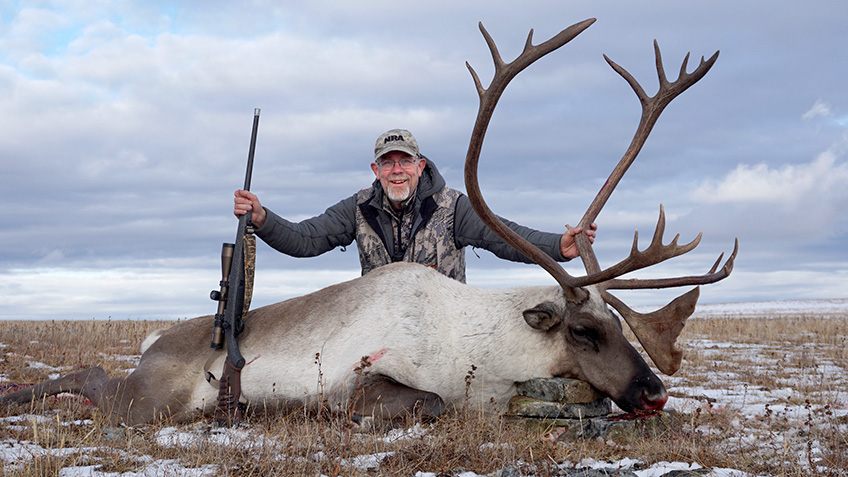
The treeless, nearly barren expanse tilted haphazardly and was pocked with run-off ditches, gravel beds and scattered boulders, some big as a cabin. The wide-open surface mosaic of stubby yellow grass and gray rock, buffeted by relentless wind, was a different world than the adjacent, timbered ridges.
Though the view from our entry point was limited by the grade, we glassed while eating lunch, and in minutes, Robin spied a band of caribou, 30 or more, grazing and loafing on the far side of a canyon. They were so far away that I wasn’t heartbroken to learn, after closer scrutiny, there wasn’t a shooter bull in the lot. Instead we packed the remaining grub into our saddlebags and set forth to survey the plateau.
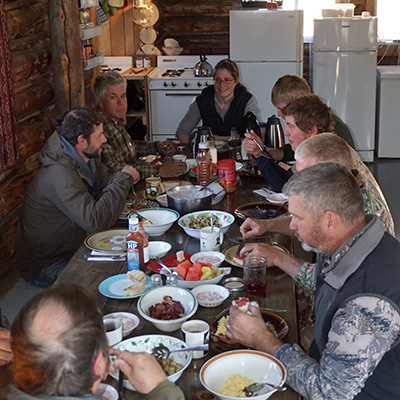
It’s not flat ground, but gentle enough to make you want to walk it. We set forth into the wind and were making good progress until I looked up to see caribou strung out along a seam of rock that formed a horizon. Though nothing but the breeze spanned the gap, the 25 animals just gawked, about half from their feet, the others bedded. We settled down to glass and possibly to shoot after I ranged them at a bit beyond my 400-yard benchmark. From prone I felt confident shooting that far, but the wind was gusting and switching, so it would require careful study to dope it properly.
With his spotting scope, Robin sorted out the bulls, including five mature ones hanging back. By that time cows toward the front were on the move, angling to our right, but perhaps would come closer if they held their current heading. Once all the bulls were up, Robin declared the next-to-last one the biggest. He was lacking key features of trophy mountain caribou—prominent shovels, bez, tops and backpoints—but Robin judged his rack uncommonly tall and wide for his race, more like a big eastern caribou. Clearly the biggest in stature, he had a snow-white cape that extended past his shoulders, but nonetheless I was unsure as we watched the parade coming closer over the open turf. Before long the first cows were drifting only 200 yards off, wary, but walking calmly. The rest followed and, when the high-racked bull stopped to stare from 240, I fired and downed him almost in his tracks. There are times to hold out for a bigger one, but fate was having none of that.
■ ■ ■
With time running short, Robin and I planned a marathon trail ride for moose, our objective a deep box canyon directly across the valley from what our guides called the Old Charley Camp.
Our trail took us near the spot where I killed a grizzly in 2011, then skirted the plateau before gradually dropping to the head of the distant gorge. It took five steady hours to ride there. The dropoff was extreme. The opposite face was heavily timbered save for a narrow vertical clearing splitting it into front and rear sections. Hopefully moose would show up in that grassy chute, and before long it happened, a lone cow feeding in the scrub willow. Then right on cue, a good bull joined her, clearly the cow’s suitor, which meant he’d stick around if she did. We had prime viewing, but from far away. My rangefinder wouldn’t pull a reading, and when I prodded Robin, he threw up his hands and grinned, “Fifteen hundred ... 2,000?” He knew only that we’d have to drop down and get closer.
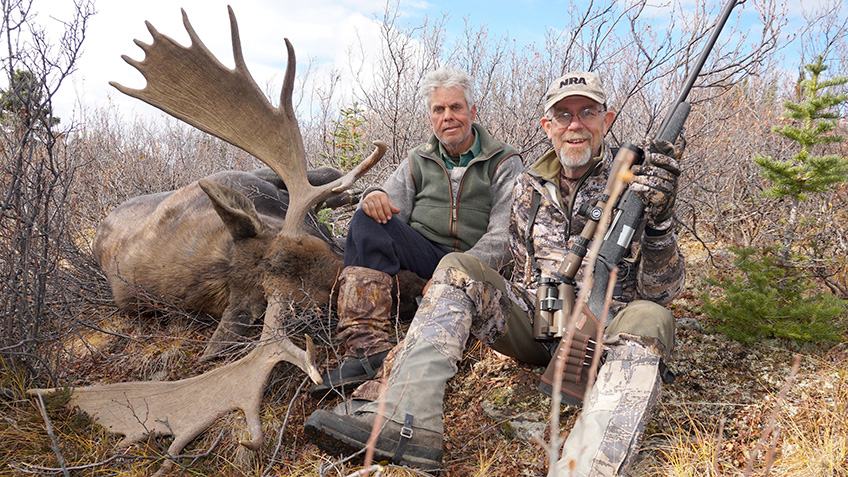
During relocation to lower ground both moose disappeared, but undeterred, Robin bawled out his sincerest moose calling. My guide must have sounded right, because darned if that bull didn’t charge out, aggressively pacing in response to the insult. Still there was no laser reading on the dark hulk, though I did get “1260” from a rockpile well below him. After briefly investigating, the bull tired of the ruse and retreated to the timber. He was not going to spare us the hellish descent/ascent to get to where Robin’s calls might earn us a shot.
Getting to the bottom didn’t take long because the pressure was on to keep moving and upright in case the horse right behind me stumbled on the steep canyon wall. Soon we were washing our faces in creek water, a cooling break from the noontime sun. Climbing out of the chasm was less thrilling but much harder, hotter work, especially since one hand was still occupied by my horse’s lead rope. It took nearly an hour to breach the low end of the open chute, and then a few more minutes to find a spot to tie off the horses. From there we continued up to where a few scrubby trees poked out into the open, an impromptu blind from which to resume calling.
At first—no response. It seemed the big fellow had cleared out. But Robin kept trying, and after 20 more minutes, here came antler tops bobbing over the brush. The bull was cautious now, but slowly advanced until halting in a knot of saplings, near enough that I could see the crazy in his eyes. But even that close, with the body screened and just head and antlers exposed, there was no shot. Finally it seemed he was going to pivot and maybe present a shot, but instead the bull kicked forward into a trot, so I jumped up and swung the big rifle, fired and saw the giant rock. Still going, he nearly made the trees as I fired again, a neck shot that flipped him. Miles in the saddle and an intense encounter culminated with this gray-brown behemoth stretched on the hillside, a gift of the north. His head was downhill, making Robin and I grunt to lift it. Though the paddles were long and nicely spread, they were only one-third the width of what qualifies as a trophy bull in that country. Not my biggest, but similar to the caribou kill, this moose was clearly meant for me.
The Unpredictability Coefficient
While unable to comment on its long-range lethality, I can testify that at 240 yards on caribou and 20 yards on that brick wall of a moose, the Edge TLR was as deadly efficient as any loading can be. It was no surprise to find complete pass-through on the caribou, or that my first hit on the moose’s near shoulder failed to exit. Upon removing that quarter, we found shattered bones and innumerable shards littering the meat. The front lobes of both lungs were pulp, and the far shoulder also was smashed. Regrettably we recovered only bits of jacket material.
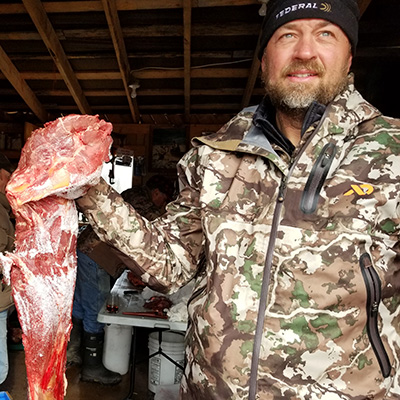
Before controlled-expansion technology, the pairing of high-speed calibers and lightweight bullets (the setup we favor today) was prone to failure—flattening, core separation, disintegration, ultimately lack of penetration—resulting in lost game, moose in particular. Given our current options, bullets fortified by cross-members, bonding or all-copper makeup, there’s no reason for any moose, elk or bear hunter to chance such failure, and our ethical code demands otherwise.
So far I’m convinced this new entry from Federal Premium will take care of business at the close end of the spectrum, and if the Edge TLR performs at long range like its Trophy Bonded and Trophy Tip forerunners, it really will serve as a do-everything load. Since we can’t know what’s going to happen when hunting big animals in wild country, that’s exactly what is needed.
Author’s Note: Observant readers will recognize that my title echoes that of an all-time favorite, “Red Letter Days in British Columbia,” by Lt. Townsend Whelen (Outdoor Life, 1906). It is my intention to salute the original, which is included in a newly issued anthology, Great American Hunting Stories, from Lyons Press Classics, lyonspress.com.




































